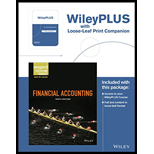
Concept explainers
(a)
Financial Statements:
A financial statement is a complete record of the financial transactions that takes place in a company at a particular point of time. It provides important financial information like assets, liabilities, revenues and expenses of the company to its internal and external users. It helps them to know the exact financial position of the company. There are four basic financial statements, they are:
- The income statement: This is a financial statement that shows the net income earned or net loss suffered by a company through reporting all the revenues earned and expenses incurred by the company over a specific period of time. Income statement is also known as operations statement, earnings statement, revenue statement, or
profit and loss statement. The net income is the excess of revenue over expenses. - The
retained earnings statement: This is a financial statement that shows the amount of the net income retained by a company at a particular point of time for reinvestment and pays its debts and obligations. It shows the amount of retained earnings that is not paid as dividends to the shareholders. - The balance sheet: This is a financial statement that shows the available assets (owner’s equity and outsider’s equity) and owed liabilities from investing and financial activities of a company. This statement reveals the financial health of company. So, this statement is also called as
Statement of Financial Position . It helps the users to know the creditworthiness of a company as to whether the company has enough assets to pay off its liabilities. The main components of balance sheet are assets, liabilities, andstockholders’ equity . - Statement of
cash flows: This is a financial statement that shows the cash and cash equivalents of a company for a particular period of time. It determines the net changes in cash through reporting the sources and uses of cash due to operating, investing, and financial activities of a company.
To ascertain: Whether notes payable appear on the income statement (IS), balance sheet (BS), or retained earnings statement (RE).
(b)
To ascertain: Whether advertising expenses appear on the income statement (IS), balance sheet (BS), or retained earnings statement (RE).
(c)
To ascertain: Whether common stock appears on the income statement (IS), balance sheet (BS), or retained earnings statement (RE).
(d)
To ascertain: Whether cash appears on the income statement (IS), balance sheet (BS), or retained earnings statement (RE).
(e)
To ascertain: Whether service revenue appears on the income statement (IS), balance sheet (BS), or retained earnings statement (RE).
(f)
To ascertain: Whether dividends appear on the income statement (IS), balance sheet (BS), or retained earnings statement (RE).
Want to see the full answer?
Check out a sample textbook solution
Chapter 1 Solutions
Financial Accounting, 10e WileyPLUS Registration Card + Loose-leaf Print Companion
- Louisa Pharmaceutical Company is a maker of drugs for high blood pressure and uses a process costing system. The following information pertains to the final department of Goodheart's blockbuster drug called Mintia. Beginning work-in-process (40% completed) 1,025 units Transferred-in 4,900 units Normal spoilage 445 units Abnormal spoilage 245 units Good units transferred out 4,500 units Ending work-in-process (1/3 completed) 735 units Conversion costs in beginning inventory $ 3,250 Current conversion costs $ 7,800 Louisa calculates separate costs of spoilage by computing both normal and abnormal spoiled units. Normal spoilage costs are reallocated to good units and abnormal spoilage costs are charged as a loss. The units of Mintia that are spoiled are the result of defects not discovered before inspection of finished units. Materials are added at the beginning of the process. Using the weighted-average method, answer the following question: What are the…arrow_forwardQuick answerarrow_forwardChoice???arrow_forward
- On November 30, Sullivan Enterprises had Accounts Receivable of $145,600. During the month of December, the company received total payments of $175,000 from credit customers. The Accounts Receivable on December 31 was $98,200. What was the number of credit sales during December?arrow_forwardPaterson Manufacturing uses both standards and budgets. For the year, estimated production of Product Z is 620,000 units. The total estimated cost for materials and labor are $1,512,000 and $1,984,000, respectively. Compute the estimates for: (a) a standard cost per unit (b) a budgeted cost for total production (Round standard costs to 2 decimal places, e.g., $1.25.)arrow_forwardQuestion: Gujri Place Clock Shop sold a grandfather clock for $2,250 subject to a 9% sales tax. The entry in the general journal will include a credit to Sales for a) $2,250.00 b) $2,092.50 c) $2,452.50. choose the correct optionarrow_forward

 AccountingAccountingISBN:9781337272094Author:WARREN, Carl S., Reeve, James M., Duchac, Jonathan E.Publisher:Cengage Learning,
AccountingAccountingISBN:9781337272094Author:WARREN, Carl S., Reeve, James M., Duchac, Jonathan E.Publisher:Cengage Learning, Accounting Information SystemsAccountingISBN:9781337619202Author:Hall, James A.Publisher:Cengage Learning,
Accounting Information SystemsAccountingISBN:9781337619202Author:Hall, James A.Publisher:Cengage Learning, Horngren's Cost Accounting: A Managerial Emphasis...AccountingISBN:9780134475585Author:Srikant M. Datar, Madhav V. RajanPublisher:PEARSON
Horngren's Cost Accounting: A Managerial Emphasis...AccountingISBN:9780134475585Author:Srikant M. Datar, Madhav V. RajanPublisher:PEARSON Intermediate AccountingAccountingISBN:9781259722660Author:J. David Spiceland, Mark W. Nelson, Wayne M ThomasPublisher:McGraw-Hill Education
Intermediate AccountingAccountingISBN:9781259722660Author:J. David Spiceland, Mark W. Nelson, Wayne M ThomasPublisher:McGraw-Hill Education Financial and Managerial AccountingAccountingISBN:9781259726705Author:John J Wild, Ken W. Shaw, Barbara Chiappetta Fundamental Accounting PrinciplesPublisher:McGraw-Hill Education
Financial and Managerial AccountingAccountingISBN:9781259726705Author:John J Wild, Ken W. Shaw, Barbara Chiappetta Fundamental Accounting PrinciplesPublisher:McGraw-Hill Education





